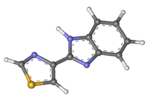Tiabendazole
 | |
 | |
| Systematic (IUPAC) name | |
|---|---|
| 4-(1H-1,3-benzodiazol-2-yl)-1,3-thiazole | |
| Clinical data | |
| Trade names | Mintezol |
| AHFS/Drugs.com | International Drug Names |
| |
| |
| oral, topical | |
| Pharmacokinetic data | |
| Metabolism | GI tract. Peak plasma 1-2 hours through oral administration |
| Half-life | 8 hours |
| Excretion | 90% I urine |
| Identifiers | |
|
148-79-8 | |
| D01AC06 P02CA02 QP52AC10 | |
| PubChem | CID 5430 |
| DrugBank |
DB00730 |
| ChemSpider |
5237 |
| UNII |
N1Q45E87DT |
| KEGG |
D00372 |
| ChEMBL |
CHEMBL625 |
| NIAID ChemDB | 007903 |
| Chemical data | |
| Formula | C10H7N3S |
| 201.249 g/mol | |
|
SMILES
| |
| |
| Physical data | |
| Density | 1.103 g/cm3 |
| Melting point | 293 to 305 °C (559 to 581 °F) |
| | |
Tiabendazole (INN, BAN), thiabendazole (AAN, USAN), TBZ and the trade names Mintezol, Tresaderm, and Arbotect) is a fungicide and parasiticide.
Uses
Fungicide
It is used primarily to control mold, blight, and other fungal diseases in fruits (e.g. oranges) and vegetables; it is also used as a prophylactic treatment for Dutch elm disease.
Use in treatment of aspergillosis has been reported.[1]
Parasiticide
As an antiparasitic, it is able to control roundworms (such as those causing strongyloidiasis),[2] hookworms, and other helminth species which attack wild animals, livestock and humans.[3]
Angiogenesis inhibitor
Genes responsible for the maintenance of cell walls in yeast have been shown to be responsible for angiogenesis in vertebrates. Tiabendazole serves to block angiogenesis in both frog embryos and human cells. It has also been shown to serve as a vascular disrupting agent to reduce newly established blood vessels. Tiabendazole has been shown to effectively do this in certain cancer cells [4]
Pharmacodynamics
TBZ works by inhibition of the mitochondrial, helminth-specific enzyme, fumarate reductase, with possible interaction with endogenous quinone.[5]
Other
Medicinally, thiabendazole is also a chelating agent, which means it is used medicinally to bind metals in cases of metal poisoning, such as lead, mercury, or antimony poisoning.
In dogs and cats, thiabendazole is used to treat ear infections.
Thiabendazole is also used as a food additive,[6][7] a preservative with E number E233 (INS number 233). For example, it is applied to bananas to ensure freshness, and is a common ingredient in the waxes applied to the skins of citrus fruits. It is not approved as a food additive in the EU,[8] Australia and New Zealand.[9]
Safety
The substance appears to have a slight toxicity in higher doses, with effects such as liver and intestinal disorders at high exposure in test animals (just below LD50 level). Some reproductive disorders and decreasing weaning weight have been observed, also at high exposure. Effects on humans from use as a drug include nausea, vomiting, loss of appetite, diarrhea, dizziness, drowsiness, or headache; very rarely also ringing in the ears, vision changes, stomach pain, yellowing eyes and skin, dark urine, fever, fatigue, increased thirst and change in the amount of urine occur. Carcinogenic effects have been shown at higher doses.[10]
Synthesis

Alternative route of synthesis: 4-thiazolecarboxamide with o-phenylenediamine in polyphosphoric acid.[12]
Synthesis of labeled thiabendazole:[13]
See also
- Fungicide use in the United States
- List of fungicides
- Cambendazole
References
- ↑ Upadhyay MP, West EP, Sharma AP (January 1980). "Keratitis due to Aspergillus flavus successfully treated with thiabendazole". Br J Ophthalmol 64 (1): 30–2. doi:10.1136/bjo.64.1.30. PMC 1039343. PMID 6766732.
- ↑ Igual-Adell R, Oltra-Alcaraz C, Soler-Company E, Sánchez-Sánchez P, Matogo-Oyana J, Rodríguez-Calabuig D (December 2004). "Efficacy and safety of ivermectin and thiabendazole in the treatment of strongyloidiasis". Expert Opin Pharmacother 5 (12): 2615–9. doi:10.1517/14656566.5.12.2615. PMID 15571478.
- ↑ Portugal R, Schaffel R, Almeida L, Spector N, Nucci M (June 2002). "Thiabendazole for the prophylaxis of strongyloidiasis in immunosuppressed patients with hematological diseases: a randomized double-blind placebo-controlled study". Haematologica 87 (6): 663–4. PMID 12031927.
- ↑ Cha, HJ; Byrom M; Mead PE; Ellington AD; Wallingford JB et al. (August 2012). "Evolutionarily Repurposed Networks Reveal the Well-Known Antifungal Drug Thiabendazole to Be a Novel Vascular Disrupting Agent". PLoS Biology 10 (8). doi:10.1371/journal.pbio.1001379. Retrieved 2012-08-21.
- ↑ Gilman, A.G., T.W. Rall, A.S. Nies and P. Taylor (eds.). Goodman and Gilman's The Pharmacological Basis of Therapeutics. 8th ed. New York, NY. Pergamon Press, 1990., p. 970
- ↑ Rosenblum C (March 1977). "Non-drug-related residues in tracer studies". Journal of Toxicology and Environmental Health 2 (4): 803–14. doi:10.1080/15287397709529480. PMID 853540.
- ↑ Sax, N.I. Dangerous Properties of Industrial Materials. Vol 1-3 7th ed. New York, NY: Van Nostrand Reinhold, 1989., p. 3251
- ↑ UK Food Standards Agency: "Current EU approved additives and their E Numbers". Retrieved 2011-10-27.
- ↑ Australia New Zealand Food Standards Code"Standard 1.2.4 - Labelling of ingredients". Retrieved 2011-10-27.
- ↑ "Reregistration Eligibility Decision THIABENDAZOLE". Environmental Protection Agency. Retrieved 8 January 2013.
- ↑ Grenda, V. J.; Jones, R. E.; Gal, G.; Sletzinger, M. (1965). "Novel Preparation of Benzimidazoles from N-Arylamidines. New Synthesis of Thiabendazole1". The Journal of Organic Chemistry 30: 259. doi:10.1021/jo01012a061.
- ↑ Brown, H. D.; Matzuk, A. R.; Ilves, I. R.; Peterson, L. H.; Harris, S. A.; Sarett, L. H.; Egerton, J. R.; Yakstis, J. J.; Campbell, W. C.; Cuckler, A. C. (1961). "Antiparasitic Drugs. Iv. 2-(4'-Thiazolyl)-Benzimidazole, A New Anthelmintic". Journal of the American Chemical Society 83 (7): 1764. doi:10.1021/ja01468a052.
- ↑ Tocco, D. J.; Buhs, R. P.; Brown, H. D.; Matzuk, A. R.; Mertel, H. E.; Harman, R. E.; Trenner, N. R. (1964). "The Metabolic Fate of Thiabendazole in Sheep1". Journal of Medicinal Chemistry 7 (4): 399. doi:10.1021/jm00334a002.
| ||||||||||||||||||||||||||||||||||||||||||||||||||||||||||||||||||||
| ||||||||||||||||||||||||||||||||||||||||||||||||||||||||||||||||